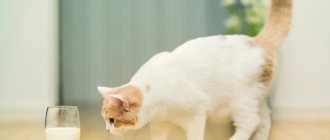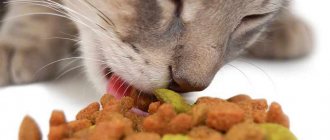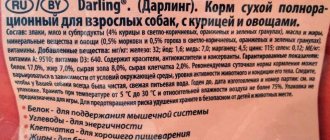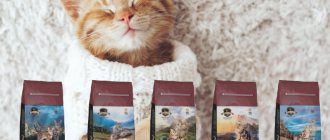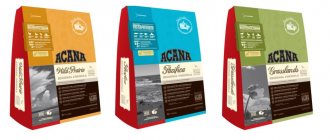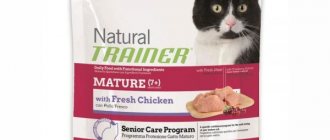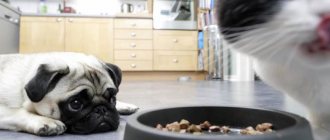What kind of cereals can cats eat?
- Pearl barley. It is very slimy, so veterinarians always recommend adding it to the diet. This is especially true for those cats that suffer from gastritis, constipation, and other diseases of the gastrointestinal tract.
- Oatmeal. Oatmeal is perfectly absorbed by the animal's body. Therefore, if you want your cat to have excellent health, then such porridge should definitely be present in the diet. Oatmeal also stimulates the gastrointestinal tract, and therefore metabolism will improve significantly. It is able to remove harmful toxins from the body. It contains gluten in large quantities, and this negatively affects calorie content.
- Rice. This porridge is considered the best food for cats that are prone to allergic reactions. Since rice does not contain gluten, it is not capable of causing allergies. It is considered useful for: heart, liver, gastrointestinal tract, blood vessels, immunity, wool. Capable of adding activity to your pet, it should always be cooked in meat broth.
- Buckwheat. Buckwheat is considered the most useful for animals, since it contains the most quickly digestible protein. This food should be given no more than 3 times a week; the porridge is cooked in meat broth. Add the vegetables your cat likes most to the dish.
Choosing the best buckwheat
Number of feedings for the kitten
How many times a day should a kitten be fed at 1, 2, 3 months? Answer: often, but little by little, giving relief to the stomach. The age of the pet plays an important role. The breaks between meals in older animals increase. How often should you feed your kitten?
Here's an example diagram:
- 4 - 8 weeks: 6 - 8 times a day.
- 2 months: 5 times a day.
- 3 months: 4 times.
- 4 - 5 months to a year: 3 times. Night feedings are cancelled.
- 13 - 15 months: 2 times.
Some owners, when asked “how much to feed a kitten,” make the mistake of reducing the number of meals. The reason is being busy at work. There should be no reductions; stick to the proposed scheme. Having trouble with frequent feedings? Use the “free method”: leave a little kefir or soft food so that your pet can satisfy his hunger.
Prohibited cereals
- Wheat. We do not refuse this, but we still do not recommend including it in the diet. The advantage is the presence of a large number of coarse fibers. They can benefit the gastrointestinal tract. The disadvantages are: large amounts of gluten, gluten. Because of this, a lot of gases are produced in the cat’s digestive system, and due to frequent consumption of such porridge, dysbiosis may appear.
- Pea. Previously, it was actively used to feed cats, but over the past 5-7 years everyone has abandoned it, and there are several reasons for this. Firstly, pea porridge provokes severe intestinal upset, and secondly, the pet develops colic, severe pain and bloating. All members of the legume group are difficult to tolerate by the kidneys and pancreas.
- Manna. This one is very harmful to bones, as it contains a lot of gluten and phytic acid. It poses a great danger to neutered cats, as they may develop urolithiasis within six months. The main advantage of semolina is that it quickly saturates the body with energy, but we still do not recommend adding a pet to the menu.
- Corn. It is poorly absorbed by the body, and it is practically not digested by the stomach. Instead of health, you can only get indigestion and severe gas formation. Corn grits can be added to the diet only on the recommendation of a veterinarian. The fact is that a doctor can prescribe it for weight loss.
- Millet. Owners are always pleased with the price of this cereal, but such savings are deplorable for the pet. Since millet is extremely constipating, it is especially dangerous for fluffies who have problems with the large intestine.
Eating porridge from one plate
Homemade food or store-bought kitten food?
Arguing about which diet is best for a growing body is a thankless task. There will be plenty of supporters of feeding homemade food, as well as opponents. Both methods of eating have a number of advantages and disadvantages, for example, cooking at home will cost less than buying specialized food, but will the owner dare to cook every day? Those who advocate for home-cooked food are stopped by the price of store-bought quality food. What to feed small cats and cats is decided by each owner, based on his own ideas and income.
- Popular foods
- New
- Stock
Proplan pouch for kittens pieces in jelly CHICKEN
Proplan Pouch for kittens pieces in jelly CHICKEN Delight your pet with the new Pro Plan® wet food in soft packaging! Our team of nutrition experts has developed…
Price: from 61
Proplan pouch for kittens TURKEY in sauce
Proplan pouch for kittens TURKEY in gravy Specially designed tender pieces in gravy for kittens that are easy to chew; Thanks to the content of PUFAs (polyunsaturated fatty acids...
Price: from 56
Dry food for kittens Pro Plan Kitten Delicate Sensitive with sensitive digestion
Dry food for kittens Pro Plan Kitten Delicate Sensitive with sensitive digestion DRY COMPLETE FOOD FOR KITTENS WITH SENSITIVE DIGESTION OR WITH SPECIAL PREFERENCES IN FOOD, WITH TURKEY; RECOMMENDED FOR…
Price: from 276
Royal Canin KITTEN Dry food for kittens
Royal Canin KITTEN Dry food for kittens Complete food for Royal Canin kittens up to 12 months DIGESTIVE SYSTEM HEALTH During the growth period, the digestive…
Price: from 220
Canned beef and turkey for dogs (beef&turkey)
Canned beef and turkey for dogs (beef&turkey)
Price: from 100
Royal Canin MAXI PUPPY (wet food for large breed dog puppies)
Royal Canin MAXI PUPPY (wet food for puppies of large breed dogs) Complete wet food for bitches at the end of pregnancy and during lactation, as well as for puppies from weaning to 2…
Price: from 768
8in1 Grills Chicken Style 80g
8in1 Grills Chicken Style 80g Crispy Grilled Chicken 8in1 (8in1) Grills Chicken - crispy snacks in the form of chicken fillet and the smell of barbecue, just removed from…
Price: from 241
- Dry food to support digestion Farmina N&D GRAIN FREE QUINOA LINE N&D DOG GRAIN-FREE LAMB AND QUINOA
Dry food to support digestion Farmina N&D GRAIN FREE QUINOA LINE N&D DOG GRAIN-FREE LAMB AND QUINOA
Price: from 975
Eukanuba Dog Adult for large breed dogs
Eukanuba Dog Adult for Large Breed Dogs Specially formulated to maintain joint health and mobility. Contains natural sources of glucosamine and sulfate...
Price: from 1253
Dog bed "Oval"
Dog bed “Oval” Material: polyester, faux fur
Price: from 780
- Dry food for kittens Farmina N&D GRAIN FREE LINE N&D CAT CHICKEN WITH POMEGRANATE
Dry food for kittens Farmina N&D GRAIN FREE LINE N&D CAT CHICKEN WITH POMEGRANATE
Price: from 400
Frontline Combo for dogs from 10 to 20 kg
Frontline Combo for dogs from 10 to 20 kg Frontline (Frontline) - a new generation remedy against ectoparasites contains a new formula: fipronil - an active and effective drug...
Price: from 555
ALL FOOD FOR KITTENS
Perhaps expert advice will help you find the right solution:
- Consider financial possibilities: it makes sense to switch to a home cooking method if good specialized nutrition is expensive.
- Buying cheap food simply means harming your small pet; The composition of ready-made food advertised on TV is distinguished by the abundance of vegetables, meat and bone meal, and the addition of flavoring additives that are so attractive to cats. An unhealthy composition will result in problems with health and well-being.
- Kitten food is an ideal solution if the owner works a lot, stays late, is tired and does not have the strength to prepare a delicious dinner for the baby; take out the bag and you're done.
- Natural products are undoubtedly healthier than store-bought cat food. When choosing a method of feeding homemade food, remember: you will have to prepare a variety of dishes to cover your pet’s daily need for microelements. Make up for the deficiency with vitamin supplements. This incurs certain financial costs, but the finished pates and granules are balanced, the composition has the necessary substances for growth and harmonious development.
- A diet based on meat and cereals is ideal for a growing body. Physiologically, the intestines of animals are adapted to process hard protein foods, so soft foods (pates) become a common cause of constipation and diarrhea.
At what age should it be given?
You can feed kittens porridge, but only starting from 2 months of age. They must be prepared with milk, this is done so that the little fluffy’s stomach is prepared for the new diet.
After a year, cats should not cook porridge with milk, as such food will cause gastrointestinal overload.
If you are going to feed an adult cat, then you need to cook it in fish or meat broth. They most likely will not eat porridge on water, and they are not so nutritious.
What to replace it with?
If pets stop drinking milk or the owner is concerned about its dubious benefits, you can pay attention to substitutes. Pet stores offer a selection of artificial milk that does not cause diarrhea and does not harm the health of cats. It is recommended that the owner pay attention to the Royal Canin Babycat Milk substitute, which is suitable even for a kitten that has stopped drinking its mother’s milk. There is an artificial product from the Whiskas brand, which contains a small amount of lactose. However, even for a cat who stops drinking natural milk, veterinarians from the Zoovet clinic recommend giving it infrequently. It is better to use it as a treat rather than as a main food.
Porridge for a castrated cat
Rice, oatmeal and buckwheat porridges are perfect for a neutered cat. If you alternate, they can restore normal digestion. Also, these cereals will bring all the necessary microelements and vitamins into the animal’s body.
Porridge with meat. looks appetizing
Several recipes
Chicken with rice and vegetables
- Boil 2 small carrots in a separate container and then grate them.
- Cook chicken thighs in a small saucepan. When the meat is boiled, you can add brown rice to the broth.
- While the rice is cooking, you can cut the chicken into small pieces.
- When the rice is cooked, let it cool slightly.
- Take one part of rice and mix with the same amount of chicken.
- Add some grated boiled carrots on top, now you can serve the delicacy.
Buckwheat porridge with stewed meat
- Buy a good stew at the store; it’s better to buy several cans at once, as some may not contain meat.
- Add a pinch of salt to the water, and after boiling, throw in the stew.
- When our broth boils, we can add buckwheat.
- The dish can be added only after it has cooled. We also recommend adding vegetables to the porridge; to do this, you can boil the beets in the microwave and then finely chop them.
What not to do
The list of foods that are strictly prohibited for cats of any age is extensive. Pets should not be given in any quantity:
- chocolate, as well as any products containing cocoa beans. They contain theobromine, which is fatal to pets. It settles in the liver, does not decompose, and gradually destroys the organ;
- coffee and tea cause severe diseases of the heart and nervous system;
- mushrooms can cause severe poisoning, in some cases instant death;
- alcohol is not excreted from the cat’s body;
- potatoes, eggplants, tomatoes contain an alkaloid that causes damage to the gastrointestinal tract;
- Avocado is extremely toxic for small hunters; persin in its composition causes severe diarrhea, vomiting, and difficulty breathing;
- Garlic and onions contain disulfite, which destroys red blood cells in cat blood. This leads to the development of anemia;
- rhubarb and sorrel cause oxalic acid poisoning and kidney failure;
- fruit grains provoke suffocation, which occurs due to intoxication with hydrocyanic acid;
- grapes, citrus fruits, raisins, persimmons cause vomiting, diarrhea, sudden renal failure; Nuts are dangerous due to their high phosphorus content.
Natural dog food is not suitable for cats, and indeed the entire organization of proper dog feeding is not suitable. It contains too little protein and taurine. If several types of animals live in the house, they will have to cook separately. You should not feed your cat any fatty, fried foods, sausages, or processed foods. It is unacceptable to give your pet vitamin and mineral complexes intended for humans.
Eating from your own table is strictly prohibited.
